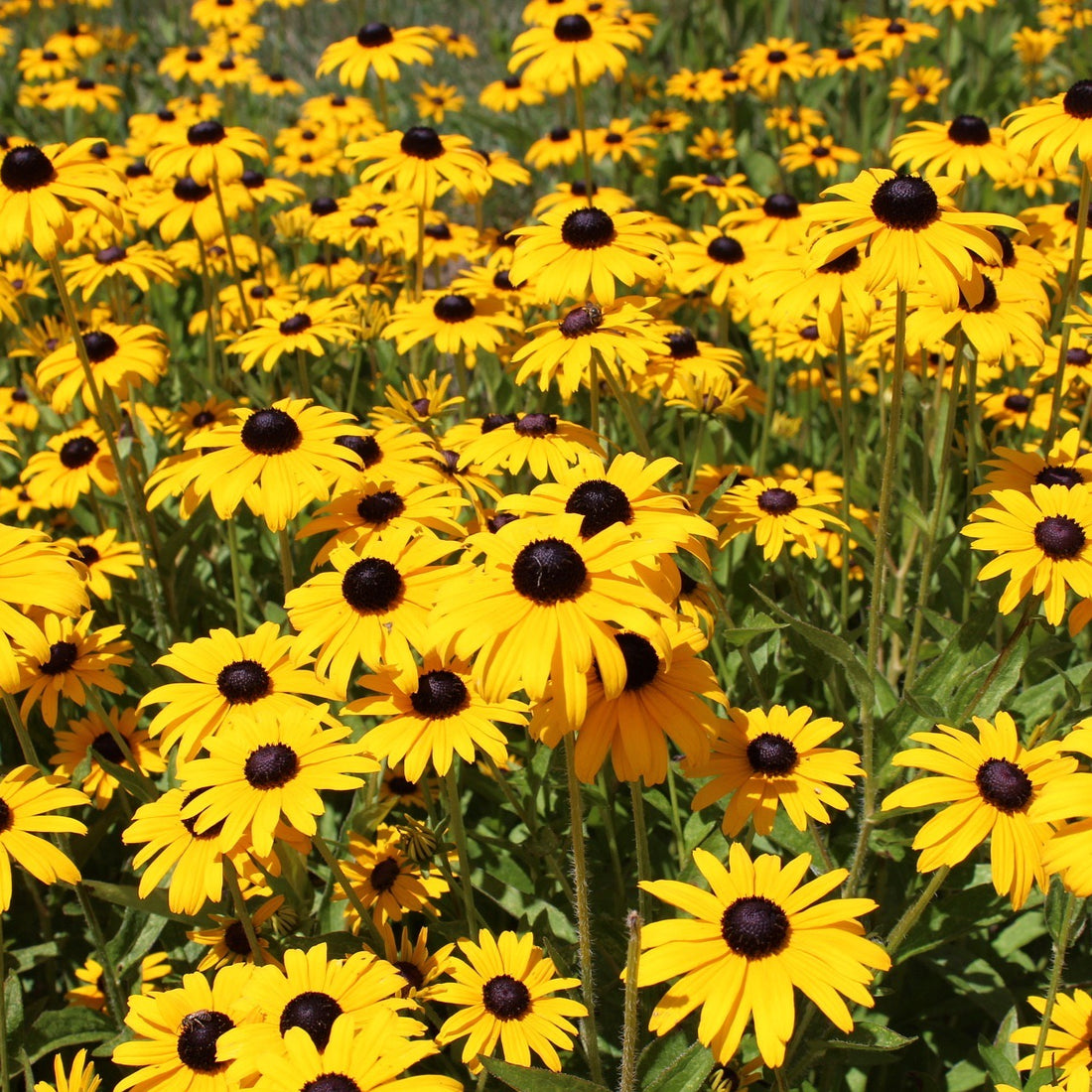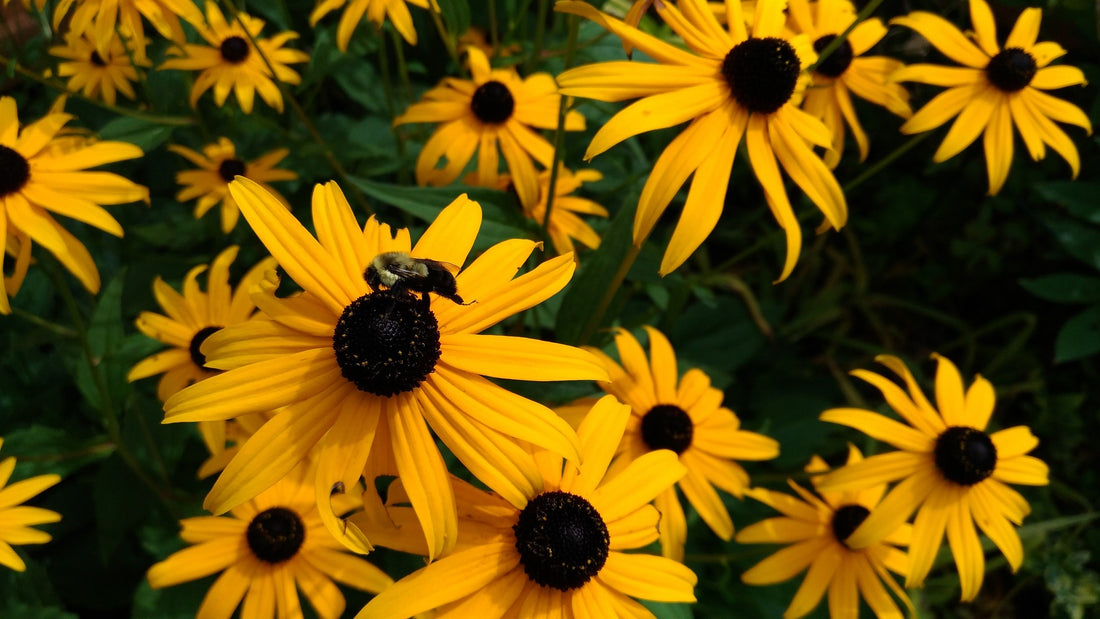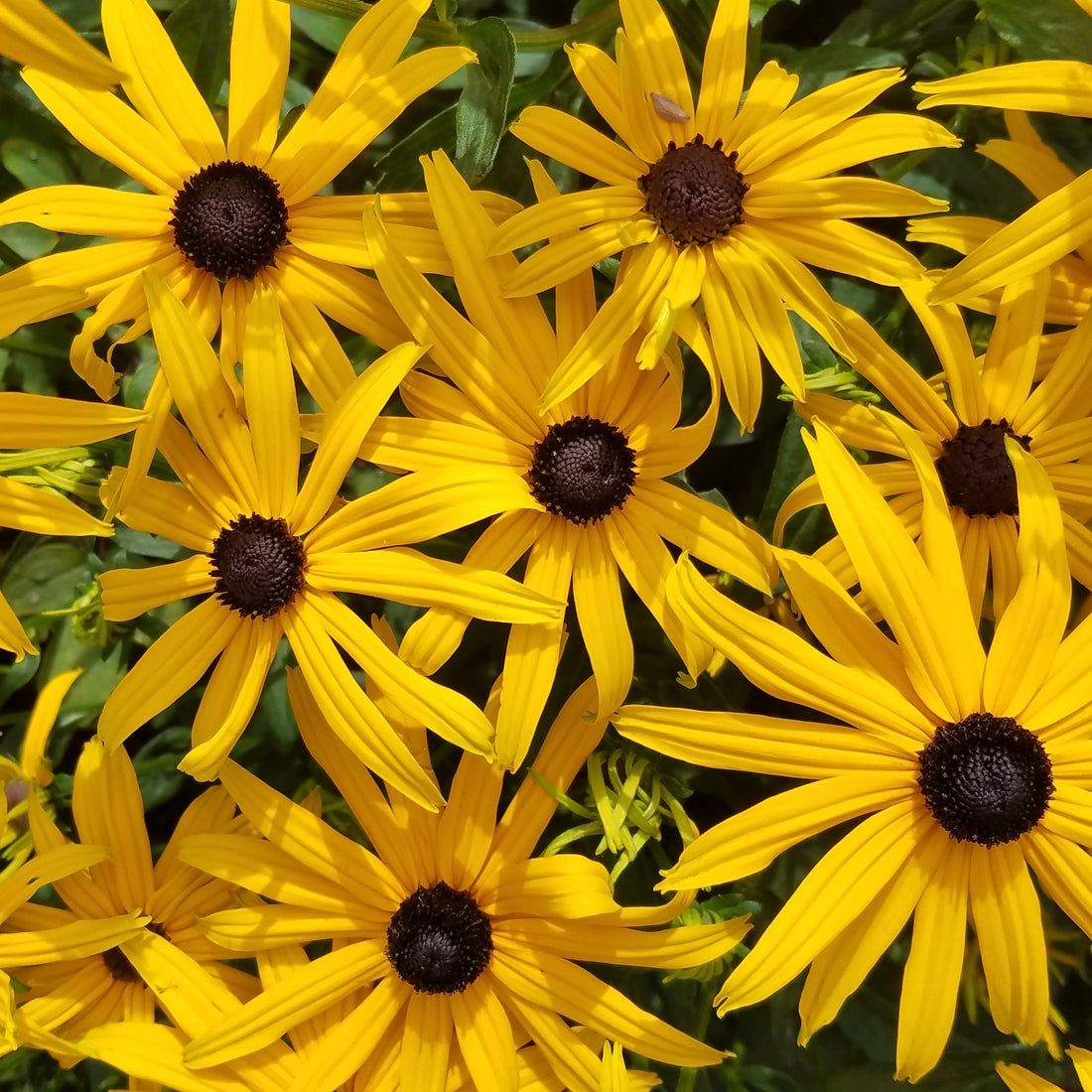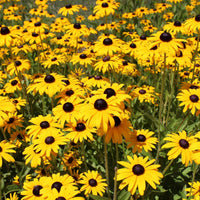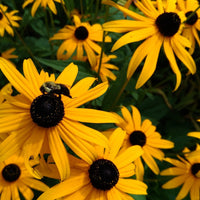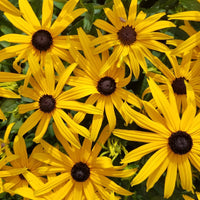
- When to plant:
- Spring, Fall
- Fertilizer:
- Varies
- Seeding rate:
- 2 lbs. per acre
- Overseeding rate:
- 1 oz. per 1,000 sq. ft.
- Seeding depth:
- 1/8 - 1/4 inch
- Ideal ph:
- 5.5 - 7.8
- Gmo:
- No
- Inoculant needed:
- No
- Coated or raw:
- Raw
- Lifecycle:
- Annual
- Climate zones:
- Cool Season, Transition Zone, Warm Season
Black-Eyed Susan is a dazzling and beloved wildflower that's native to North America. Black-Eyed Susan’s distinctive appearance is characterized by brilliant golden-yellow petals that surround a dark brown center, resembling an eye-catching daisy. This perennial beauty is a symbol of summer, known for its resilience, vibrant hues, and widespread appeal among gardeners and nature enthusiasts alike.
Product Information
- Botanic Name: Rudbeckia hirta
- Application or Use: Ornamental, Conservation, Habitat
- Germination Time: 7 - 14 days, under optimal conditions
- Growing Locations: Warm Season, Transition Zone, Cool Season
- Height: 2 - 3 feet
- Sunlight Requirements: 8+ hours, full sun for best results
- Advantages: Adapted to many soil types; showy blooms, excellent for landscaping; attracts pollinators.
- When to Plant: See instruction tab.
Product Information
Black-Eyed Susan is a dazzling and beloved wildflower that's native to North America. Black-Eyed Susan’s distinctive appearance is characterized by brilliant golden-yellow petals that surround a dark brown center, resembling an eye-catching daisy. This perennial beauty is a symbol of summer, known for its resilience, vibrant hues, and widespread appeal among gardeners and nature enthusiasts alike.
Growing up to around 2 to 3 feet tall, the Black-Eyed Susan boasts sturdy stems crowned with abundant blooms, making it a standout in gardens, borders, and meadows. It's a favorite among pollinators like butterflies and bees, adding an extra touch of life and activity to your outdoor space.
One of the most admirable qualities of the Black-Eyed Susan is its hardiness. Thriving in various soil types and adaptable to different environments, this wildflower is relatively low-maintenance, making it an excellent choice for both experienced gardeners and beginners looking to add a burst of color to their landscape. Its long-lasting blooms from mid-summer well into fall bring joy and warmth to any garden or floral arrangement.
Not just a pretty face in the garden, the Black-Eyed Susan is often used in landscaping to attract beneficial insects, contribute to natural habitats, and provide an enduring display of natural beauty. Whether planted in groups, mixed with other perennials, or displayed in bouquets, the Black-Eyed Susan adds a touch of sunshine and charm to any setting, embodying the spirit of summer and bringing a cheerful vibrancy wherever it blooms.
*Product packaging may appear different than what is pictured.
Wildflower Planting Time Based on Region:
Southeast
- Fall, Winter: Sowing wildflowers in Fall/Winter is the ideal time in the Southeast, with October 1 – December 31 being the best dates. The weather is ideal for starting seeds, and seedlings can grow and harden off before frost.
- Spring: A good time to plant wildflowers, especially annual species that flower quickly. Plant after the last frost date when soil temperatures have warmed to around 55°F, typically occurring within a month or so after the final frost of winter; this ensures the seeds can germinate properly without being affected by cold weather.
- Summer: You can plant wildflower seeds in the summer, but the hot sun can dry out the soil and stress your seedlings. Summer is a good time to plant quick-growing annual wildflowers.
Southwest
- Fall: A good time to plant spring wildflowers in the desert Southwest. Fall's cooler temperatures and seasonal rains help seeds germinate. In the mountains, you can plant after spring frosts.
- Winter: In areas that get snow, winter seeding can give seeds an advantage in the spring.
- Spring: A popular time to plant wildflowers in most states. You can plant after the last frost and when the soil temperature is at least 55°F. In warmer climates, you can plant at the end of the rainy season.
- Summer: You can plant wildflower seeds in the summer, but the hot sun can dry out the soil and stress your seedlings. Summer is a good time to plant quick-growing annual wildflowers.
Northeast
- Fall, Winter: The best time to plant wildflowers in the Northeast is in late fall, after the first frost but before heavy snow. This is known as dormant seeding and can take place from November to December. Cold temperatures and damp soil during the winter help wildflower seeds germinate.
- Spring: Plant in early spring, after the ground has thawed and soil temperatures reach around 55-65°F. This is a popular time to plant wildflowers because it's typically rainier, which helps water seedlings.
- Summer: You can plant wildflower seeds in the summer, but the hot sun can dry out the soil and stress your seedlings. Summer is a good time to plant quick-growing annual wildflowers.
Midwest
- Fall, Winter: Plant in late fall (November–December) after the first frost. The seeds will overwinter and germinate in the spring. Fall planting is a good option for cooler climates and can give the seeds an early start in the spring.
- Spring: Plant in early spring (April–May) after the last frost when the soil temperature is consistently above 55°F. Spring is a popular time to plant because the soil is usually moist from rain, and you can see the wildflowers grow right away.
- Summer: You can plant wildflower seeds in the summer, but the hot sun can dry out the soil and stress your seedlings. Summer is a good time to plant quick-growing annual wildflowers.
Western
- Fall, Winter: Plant in late fall (November–December) after the first frost. The seeds will overwinter and germinate in the spring. Fall planting is a good option for cooler climates and can give the seeds an early start in the spring.
- Spring: Plant in early spring (April–May) after the last frost when the soil temperature is consistently above 55°F. Spring is a popular time to plant because the soil is usually moist from rain, and you can see the wildflowers grow right away.
- Summer: You can plant wildflower seeds in the summer, but the hot sun can dry out the soil and stress your seedlings. Summer is a good time to plant quick-growing annual wildflowers.
Pacific Northwest
- Fall, Winter: Plant in late fall (November–December) after the first frost. The seeds will overwinter and germinate in the spring. Fall planting is a good option for cooler climates and can give the seeds an early start in the spring.
- Spring: Plant in early spring (April–May) after the last frost when the soil temperature is consistently above 55°F. Spring is a popular time to plant because the soil is usually moist from rain, and you can see the wildflowers grow right away.
- Summer: In cooler zones with higher elevation, you can plant wildflowers in late spring to early summer, after the risk of frost has passed. You can plant wildflower seeds in the summer, but the hot sun can dry out the soil and stress your seedlings. Summer is a good time to plant quick-growing annual wildflowers.
When choosing to start a new lawn, remove old vegetation by using a de-thatcher, power rake or tiller to kill the existing vegetation. Rake or drag the area to remove debris and dead grass for a clean area. Ensure the soil is leveled and loosened to allow the seed to have good soil contact once spread on a clean seed bed.
If you have an area with heavy weed coverage, we recommend starting fresh by killing and removing the existing vegetation. If you choose to use chemicals, herbicides or fertilizers, you must check with the product's manufacturer prior to planting new seed to ensure the proper waiting period.
When overseeding an existing area, mow your lawn at the lowest setting and bag the clippingsx. Rake or drag any areas that have dead thatch or debris.

Seed Quality
Hancock Seed is dedicated to delivering the best seeds possible to our customers. Hancock Seed grows and harvests many of our products, and we acquire the majority of the rest from other family farmers.
All these seeds are processed, packaged and shipped from Hancock Farm. This helps us ensure that our high standards are met. Unlike much of the competition, we refuse to sell you a seed that was not gathered during the last harvest. You will always receive fresh product from Hancock.
Every seed we grow comes with 40 years of experience behind it...you can rest assured that all of our products are cultivated in a method that assures its potential for growth.

Your cart ( 0 )

Black-Eyed Susan is a dazzling and beloved wildflower that's native to North America. Black-Eyed Susan’s distinctive appearance is characterized by brilliant golden-yellow petals that surround a dark brown center, resembling an eye-catching daisy. This perennial beauty is a symbol of summer, known for its resilience, vibrant hues, and widespread appeal among gardeners and nature enthusiasts alike.
Product Information
- Botanic Name: Rudbeckia hirta
- Application or Use: Ornamental, Conservation, Habitat
- Germination Time: 7 - 14 days, under optimal conditions
- Growing Locations: Warm Season, Transition Zone, Cool Season
- Height: 2 - 3 feet
- Sunlight Requirements: 8+ hours, full sun for best results
- Advantages: Adapted to many soil types; showy blooms, excellent for landscaping; attracts pollinators.
- When to Plant: See instruction tab.
Product Information
Black-Eyed Susan is a dazzling and beloved wildflower that's native to North America. Black-Eyed Susan’s distinctive appearance is characterized by brilliant golden-yellow petals that surround a dark brown center, resembling an eye-catching daisy. This perennial beauty is a symbol of summer, known for its resilience, vibrant hues, and widespread appeal among gardeners and nature enthusiasts alike.
Growing up to around 2 to 3 feet tall, the Black-Eyed Susan boasts sturdy stems crowned with abundant blooms, making it a standout in gardens, borders, and meadows. It's a favorite among pollinators like butterflies and bees, adding an extra touch of life and activity to your outdoor space.
One of the most admirable qualities of the Black-Eyed Susan is its hardiness. Thriving in various soil types and adaptable to different environments, this wildflower is relatively low-maintenance, making it an excellent choice for both experienced gardeners and beginners looking to add a burst of color to their landscape. Its long-lasting blooms from mid-summer well into fall bring joy and warmth to any garden or floral arrangement.
Not just a pretty face in the garden, the Black-Eyed Susan is often used in landscaping to attract beneficial insects, contribute to natural habitats, and provide an enduring display of natural beauty. Whether planted in groups, mixed with other perennials, or displayed in bouquets, the Black-Eyed Susan adds a touch of sunshine and charm to any setting, embodying the spirit of summer and bringing a cheerful vibrancy wherever it blooms.
*Product packaging may appear different than what is pictured.
Wildflower Planting Time Based on Region:
Southeast
- Fall, Winter: Sowing wildflowers in Fall/Winter is the ideal time in the Southeast, with October 1 – December 31 being the best dates. The weather is ideal for starting seeds, and seedlings can grow and harden off before frost.
- Spring: A good time to plant wildflowers, especially annual species that flower quickly. Plant after the last frost date when soil temperatures have warmed to around 55°F, typically occurring within a month or so after the final frost of winter; this ensures the seeds can germinate properly without being affected by cold weather.
- Summer: You can plant wildflower seeds in the summer, but the hot sun can dry out the soil and stress your seedlings. Summer is a good time to plant quick-growing annual wildflowers.
Southwest
- Fall: A good time to plant spring wildflowers in the desert Southwest. Fall's cooler temperatures and seasonal rains help seeds germinate. In the mountains, you can plant after spring frosts.
- Winter: In areas that get snow, winter seeding can give seeds an advantage in the spring.
- Spring: A popular time to plant wildflowers in most states. You can plant after the last frost and when the soil temperature is at least 55°F. In warmer climates, you can plant at the end of the rainy season.
- Summer: You can plant wildflower seeds in the summer, but the hot sun can dry out the soil and stress your seedlings. Summer is a good time to plant quick-growing annual wildflowers.
Northeast
- Fall, Winter: The best time to plant wildflowers in the Northeast is in late fall, after the first frost but before heavy snow. This is known as dormant seeding and can take place from November to December. Cold temperatures and damp soil during the winter help wildflower seeds germinate.
- Spring: Plant in early spring, after the ground has thawed and soil temperatures reach around 55-65°F. This is a popular time to plant wildflowers because it's typically rainier, which helps water seedlings.
- Summer: You can plant wildflower seeds in the summer, but the hot sun can dry out the soil and stress your seedlings. Summer is a good time to plant quick-growing annual wildflowers.
Midwest
- Fall, Winter: Plant in late fall (November–December) after the first frost. The seeds will overwinter and germinate in the spring. Fall planting is a good option for cooler climates and can give the seeds an early start in the spring.
- Spring: Plant in early spring (April–May) after the last frost when the soil temperature is consistently above 55°F. Spring is a popular time to plant because the soil is usually moist from rain, and you can see the wildflowers grow right away.
- Summer: You can plant wildflower seeds in the summer, but the hot sun can dry out the soil and stress your seedlings. Summer is a good time to plant quick-growing annual wildflowers.
Western
- Fall, Winter: Plant in late fall (November–December) after the first frost. The seeds will overwinter and germinate in the spring. Fall planting is a good option for cooler climates and can give the seeds an early start in the spring.
- Spring: Plant in early spring (April–May) after the last frost when the soil temperature is consistently above 55°F. Spring is a popular time to plant because the soil is usually moist from rain, and you can see the wildflowers grow right away.
- Summer: You can plant wildflower seeds in the summer, but the hot sun can dry out the soil and stress your seedlings. Summer is a good time to plant quick-growing annual wildflowers.
Pacific Northwest
- Fall, Winter: Plant in late fall (November–December) after the first frost. The seeds will overwinter and germinate in the spring. Fall planting is a good option for cooler climates and can give the seeds an early start in the spring.
- Spring: Plant in early spring (April–May) after the last frost when the soil temperature is consistently above 55°F. Spring is a popular time to plant because the soil is usually moist from rain, and you can see the wildflowers grow right away.
- Summer: In cooler zones with higher elevation, you can plant wildflowers in late spring to early summer, after the risk of frost has passed. You can plant wildflower seeds in the summer, but the hot sun can dry out the soil and stress your seedlings. Summer is a good time to plant quick-growing annual wildflowers.
Instructions
When choosing to start a new lawn, remove old vegetation by using a de-thatcher, power rake or tiller to kill the existing vegetation. Rake or drag the area to remove debris and dead grass for a clean area. Ensure the soil is leveled and loosened to allow the seed to have good soil contact once spread on a clean seed bed.
If you have an area with heavy weed coverage, we recommend starting fresh by killing and removing the existing vegetation. If you choose to use chemicals, herbicides or fertilizers, you must check with the product's manufacturer prior to planting new seed to ensure the proper waiting period.
When overseeding an existing area, mow your lawn at the lowest setting and bag the clippingsx. Rake or drag any areas that have dead thatch or debris.















